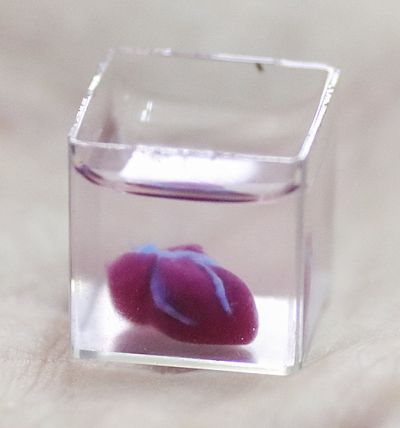Focus: creation news and views 41(4)
Water problems on Pluto

Scientists recently found that the dwarf planet Pluto likely has a deep ocean of liquid water underneath its thick ice cap. A layer of gas hydrates (gas trapped within ice), between the ice cap and the liquid water, apparently provides insulation for the ocean, preventing it from freezing. Just like a hot potato kept warm in a coat pocket, the scientists propose that heat within Pluto has been trapped beneath the frozen ice-cap.
However, this creates big problems for secular scientists. One is that they acknowledge there is no possibility of Pluto being heated via such things as tidal heating, where gravitational friction creates heat, because Pluto is much too far away from planets. And with the alleged enormous age of 4.6 billion years for Pluto, it is unthinkable that heat on such a relatively small body could last so long without radiating away into the deep cold of space.
A liquid ocean, so far from the heat of the sun, means that Pluto must be much younger than conventionally claimed.
- Wall, M., Pluto has a buried ocean—and so might many other worlds, space.com, 20 May 2019.
The chances of finding aliens get even slimmer

Despite decades of searching for extra-terrestrial life, no evidence has been found. So far, life on Earth is unique and lives in what is called the habitable zone of our solar system. This is where Earth is the right distance from the sun to neither roast nor freeze and be able to sustain liquid water. However, to sustain (note—not generate), complex aerobic life on Earth, additional criteria are essential. In addition, any such host planet would need a suitable atmosphere. Planets with high levels of carbon dioxide or carbon monoxide would be lethal for life. What is needed to host life is the correct mixture of all these gases.
In a new study looking at the additional atmospheric constraints the true habitable zone became significantly reduced. “Once carbon dioxide toxicity is factored into the equation, the traditional habitable zone for simple animal life is sliced in two,” the researchers said. The researchers found that for complex life such as humans, which is more sensitive to high levels of carbon dioxide, this safe zone shrinks to less than a third of the traditional area.
Despite almost 4,000 exoplanets having been discovered so far, none of them have been like Earth or suitable to host life. Of course, from the Bible we know that Jesus is the author of life (Acts 3:15), which was specially created only on Earth. And any search for evolved aliens is in vain.
- Schwieterman, E.W. and four others, A limited habitable zone for complex life, Astrophysics J. 878(19), June 2019.
- Geggel, L., Alien life could be hiding out on far fewer planets than we thought, livescience.com, 10 June 2019.
High price of Darwin’s Origin

A first edition (1859) of Charles Darwin’s Origin of Species has sold for more than half a million dollars.
Bonhams auction house said the 160-year-old book was sold to an anonymous telephone buyer following a four-way bidding battle. Darwin had originally presented this copy as a gift to German botanist Robert Caspary—it bears the inscription “Professor Caspary / Koenigsberg / from the author.”
The sale price of US$500,075 (€445,000) set a world record. But it pales in comparison to the high price exacted by darwinism upon our humanity, culture, and society. See e.g. creation.com/darwin-effect.
- Copy of Charles Darwin’s ‘Origin of Species’ sells for record half million, dw.com, 15 June 2019.
Clay seal of King Josiah’s official found



Archaeologists were excited by the discovery of a seal and a small clay seal impression (bulla), with ancient Hebrew script on them on the western slope of the City of David, Jerusalem. The 2,700-year-old seal impression translates as “[belonging] to Nathan-Melech, Servant of the King”. In 2 Kings 23:11 Nathan-Melek is named as an official of the godly King Josiah of Judah (7th century BC).
The items were found inside the remains of a large public administrative building that was likely destroyed during the Babylonian destruction of Jerusalem in 586 BC. Archaeologist Dr Yiftah Shalev of the Israel Antiquities Authority explained, “What is important is not just that they were found in Jerusalem, but [that they were found] inside their true archaeological context. It is not a coincidence that the seal and the seal impression are found here.”
This wonderful find serves to connect another specifically named individual from the Bible to real physical history in the correct time period, confirming that we can be confident the Bible is reliable.
- Borschel-Dan, A., Tiny First Temple find could be first proof of aide to biblical King Josiah, timesofisrael.com, 31 Mar 2019.

Jellyfish inspires a waterproof, self-healing ‘skin’
The humble jellyfish has inspired scientists in Singapore to produce a transparent, waterproof, self-repairing skin. This could be applied to increase the water resistance of cell-phones. It could also enable robots to work underwater.
Assistant Professor Benjamin Tee, National University of Singapore (NUS), pointed out that existing self-healing materials are not transparent and can’t work in wet conditions. The material developed at NUS retains its shape in wet and dry conditions. It also works well in sea water, and in acid or alkaline conditions.
The team saw that jellyfish skin had the properties needed and they developed an artificial material to mimic it, adding touch sensitivity as well. This is another example of bio-inspiration that illustrates the fact that the Creator thought of it first.
- Jellyfish inspire a waterproof electronic skin for use in touch screens and soft robots, createdigital.org.au, 19 Mar 2019.
Photoshop-enhanced colourful squirrel?
When amateur photographer Kaushik Vijayan uploaded his images of the Indian giant squirrel Ratufa indica to Instagram, they quickly went ‘viral’ on the internet.

Some people viewing the pictures found it hard to believe that such colourful squirrels actually exist. But National Geographic confirmed that the species, also known as the Malabar giant squirrel, is real, although Miami University senior lecturer in evolutionary biology Dana Krempels suspects that some of the really bright Instagram photos may have been enhanced. “It’s very possible that someone took a bit of Photoshop license to these pics. There’s a setting called ‘vibrance’ that enhances color intensity. That’s what it looks like to me.”
Krempels might have a point, given that online-accessible video footage of the Malabar giant squirrel’s hues lack the vibrancy of Vijayan’s Instagram stills. However, it is indisputable that Ratufa indica stands out from other squirrel species, with its “vibrant splotches of black, cream, and burnt fuchsia.” National Geographic said it “makes one wonder why evolution would select for pelage, or fur, that would call so much attention to itself.”
But from a Creation/Fall/Flood perspective, these colourful squirrels of India, not so far from the Ark’s landing site, might be closest to the beauty of the first squirrels. That was in a ‘very good’ pre-Curse world, before predators, mutations and the like took the gloss off the Creator’s artistry.
- Bittel, J., Giant purple squirrels do exist—and they have an odd behavior, nationalgeographic.com, 4 Apr 2019.
Israel puts a Hebrew Bible on the moon
You may have heard of the failure of the Israeli moon mission on 12 April 2019. Interestingly, the lander was called Beresheet, the first word in the Hebrew Bible, meaning ‘in the beginning’.

Beresheet was a small, privately-funded space vehicle about the size of a washing machine. Part of its payload, destined for the lunar surface, was a ‘time capsule’—a small disc designed to survive in the harsh environment of space. Part of that was a copy of the Torah, the first 5 books of the Hebrew Bible.
Unfortunately, the engine failed to reignite at about 10 km above the lunar surface, and so the spacecraft, unable to slow its descent, crashed. NASA has since spotted debris at the landing site.
The lander and its Hebrew Bible are now lying on the lunar surface (in pieces). So those on the next mission to the moon will have something to read—including how God created the moon on the 4th day of Creation Week some 6,000 years ago.
- Israel to put Bible on the moon, Netanyahu says, foxnews.com, 16 May 2019.
- NASA Captures Images of Israeli Spacecraft’s Lunar Crash Site, haaretz.com, 15 May 2019.
3D heart printed using adult stem cells

In a world first, a team of Israeli scientists have printed a rabbit-sized 3D human heart. “This is the first time anyone anywhere has successfully engineered and printed an entire heart replete with cells, blood vessels, ventricles and chambers,” said Professor Tal Dvir, lead researcher on the study. The team took cells from an adult patient’s fatty tissue, reprogrammed them to become stem cells, and then manipulated them to become heart cells. These were then combined with a personalized extracellular hydrogel material from the same patient which was used as the bio-ink for printing.
The results will now allow further study of engineering personalized tissue for patients to help reduce the chances of rejection by the body’s immune system. Once again, this is an amazing result using adult stem cells and not embryonic stem cells, which are intimately linked to the horror of abortion and the destruction of human embryos (cf. creation.com/stem-cells).
Further, the many years of teamwork, applying lots of intelligence, and using stem cells that have already been created by God, demonstrates how much super-intelligence went into the creation of hearts to start with!
- Noor, N., and 5 others, 3D printing of personalized thick and perfusable cardiac patches and hearts, Advanced Science, 15 Apr 2019.
- Brewis, H., Scientists print 3D heart with human tissue in world first, standard.co.uk, 15 Apr 2019.
“Hellish” new planet found that should not exist

A new large gas-giant planet, the size of Neptune, has been found ‘too close’ to its parent star, which is why astronomers were shocked to discover it.
According to known planetary formation theory, it just shouldn’t exist. To add to that, it has been determined to have a mass 20 times that of Earth and a surface temperature of about 1,000°C. No wonder it has been dubbed the ‘Forbidden Planet’ that would “melt a human in under a second”.
Being as hot as it is, if it were tens of millions of years old as evolutionary theory suggests, then, being mostly gas, this should have nearly completely evaporated from the strong, hot radiation from the nearby star.
The research leader, Dr Richard West from the University of Warwick, explained: “This planet must be tough, it is right in the zone where we expected Neptune-sized planets could not survive.”
But there it is anyway! This should surely cause a rethink in the standard model of planetary formation theory. A simple explanation is that it is not so old, and that the Creator is responsible for the wide variety He has placed in the heavens.
- Edwards, C., Newly found hellish world dubbed ‘The Forbidden Planet’ would melt a human in under a second, thesun.co.uk, 29 May 2019.
Neandertals walked like us

Yet another study underlines what creationist scientists have been saying for many years—that Neandertals were fully human. Now it applies to the way that they walked—did they walk hunched, or upright like us? A detailed study of the stresses evident between vertebrae and in the pelvic area of a well-preserved Neandertal skeleton (from La Chapelle-aux-Saints, France) showed that the spine must have had a well-designed ‘double-s’ curvature like ours.
“On the whole, there is hardly any evidence that would point to Neanderthals having a fundamentally different anatomy,” explained Martin Haeusler, from the University of Zurich. “Now is the time to recognise the basic similarities between Neanderthals and modern humans,” he said.
Neanderthals walked upright just like the humans of today, sciencedaily.com; 25 Feb 2019.
- Haeusler, M. and six others, Morphology, pathology, and the vertebral posture of the La Chapelle-aux-Saints Neandertal, PNAS 116 (11):4923¨C4927, 2019.
- Cassella, C., We have been wrong about a key feature of Neanderthals’ appearance, sciencealert.com, 1 March 2019.
Siberian ice age foal still has liquid blood and urine

We previously reported (Creation 41(1):7) the breathtaking discovery of a fully intact two-month-old foal in Siberian permafrost. It is from a now-extinct species, the Lena horse, which roamed Siberia towards the end of the Ice Age—a logical consequence of the warmer oceans after the Flood (see pp. 44–47 this issue).
Now in an exciting new development, the joint Russian-Korean team discovered blood in the blood vessels and urine in the bladder. The internal organs are “beautifully preserved”, with muscle tissue retaining its natural reddish colour (from myoglobin). The team now claim it to be the best-preserved Ice Age animal ever known.
Emerging details show the foal drowned in a slurry of mud and silt, some of it found in its intestinal tract, which was then frozen into permafrost. Semyon Grigoryev, head of the Mammoth Museum in Yakutsk, said that both the animal’s death and preservation happened quickly.
Even given this maximally favourable environment, finding liquid blood and urine considerably stretches the credibility of the team’s claimed age for the foal of 42,000 years. While still amazing, such a find is much more believable within a biblical timescale, the foal living on the Siberian plains towards the end of the Ice Age only 3,500–4,000 years ago.
- Stewart, W., Scientists have found liquid blood in the frozen remains of a 42,000-year-old foal of an extinct horse that was preserved in Siberian permafrost, dailymail.co.uk, 16 Apr 2019.
- Mezzofiore, G, Liquid blood and urine have been found inside a prehistoric 42,000-year-old foal, edition.cnn.com, 19 Apr 2019.
‘Oldest’ frog hopping tracks

A frog’s hopping locomotion has been discovered fossilized in the Jinju Formation, South Korea. The newly identified tracks are considered to represent the ichnogenus Ranipes. (An ichnogenus is a classification based solely on fossil traces such as tracks or burrows where these are deemed to be distinctive and not from a type known from other evidence.) The team found three partial trackways, and various additional tracks, with recognizable complete or partial hop sets. They were found in Lower Cretaceous rocks (supposedly 145–100 million years old) making them the ‘oldest’ known frog tracks in an evolutionary worldview.
This is the fifth set of fossil frog trackways discovered. The research team noted that the rarity of frog tracks “is probably due to bias against preservation of small tracks, due to scarcity of suitable substrates, and shortcomings in observer skill or research efforts.” Indeed, to be able to locate and identify such trackways, in this case only up to 16 mm long and 9 mm wide, takes considerable skill. So, too, does identifying the other tracks in the Jinju Formation, representing theropods, sauropods, pterosaurs, crocodylians, lizards, turtles, and various mammals.
Whether rare like these frog tracks, or otherwise, tracks in general are not expected from slow and gradual processes over long time periods. As everyday experience confirms, tracks left in mud do not have any chance of being preserved long-term—unless soon after their formation they are buried rapidly under a layer of waterborne sediment. This is highly consistent with conditions prevailing during the Genesis Flood. Such ‘ephemeral’ fossils, including also ripple marks, are a widespread phenomenon in the rock record.
- Kim, K-S., Lockley, M., Lim, J-D., Kim, D-H., The oldest known anuran (frog) trackways from the Jinju Formation, Lower Cretaceous, Korea, Cretaceous Research 96:142–148, Apr 2019.


Readers’ comments
Comments are automatically closed 14 days after publication.